Patrol:
The Haus Kiap at Tababe
The Haus Kiap at Tababe
| In September, 1963, after we had been in Gunts for six months, we felt we knew the various members of the Fungai families quite well. We had filmed and photographed men, women, and children at work and play, yet, with few exceptions, we had never seen entire families gathered together. Our photo collection contained nothing like what we thought of as complete “family portraits.” |
| We had also not yet experienced a visit from the Kiap – the Patrol Officer in Simbai. One of the Kiap’s official duties was to keep the census records up to date. The Kiap who was on duty when we were there rode his motorcycle to visit clans near Simbai. He had, however, not yet managed to get the Kiap Road in the lower Simbai Valley cleared and widened sufficiently so that his motorcycle could get through. Therefore, to come to the Fungai area - a 3 to 4 days’ walk from Simbai, he, or other officials such as Australian agricultural officers or medical officers, had to organize major expeditions, ‘patrols’ consisting of police constables, a clerk, and a number of carriers. The whole group would stop each night in a different haus kiap. There was great excitement when a patrol would arrive at Tababe, the Haus Kiap that was about an hour’s walk north from Gunts and was officially designated by the Australian Administration as the gathering place for all the people of the Fungai, Korama, Bomagai, and Angoian clans. |
| Allison: “The visit of a Medical Patrol at the end of September to carry out a Malaria Survey brought all the people together, family by family. Marek was called on to help weigh and measure each person, and I was finally able to take “family portraits”. What life among the Maring almost never achieved, i.e. spatial gatherings by family, was easily achieved by the Western-style organization of an official Patrol.” |
| Everyone was in full bilas for the occasion. The Bomagais and Angoians were the first to be called. I easily recognized the men who had helped build our house and had frequently visited Gunts. |
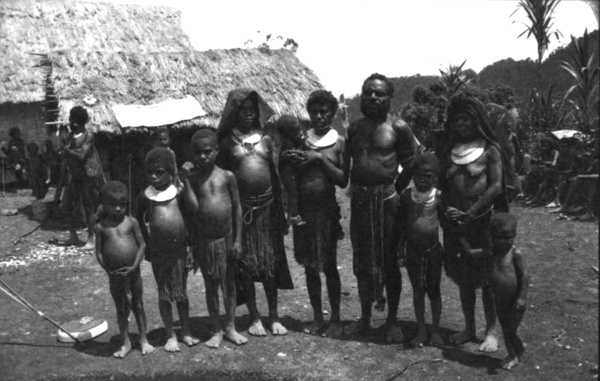
159-25: Bosboi Giribo and his family line up in front of the Patrol Officer.
| It was a lovely day with clouds scudding through the sky. For a moment, Fogaikump mountain stood out darkly behind the bright rooftops of the Haus Kiap and the haus kuk. In the background, Kabi and others waiting their turn stood around, smiling. |
|
Then it was the turn of the people
of
the Korama clan.
|
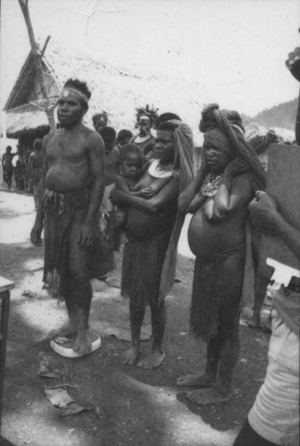
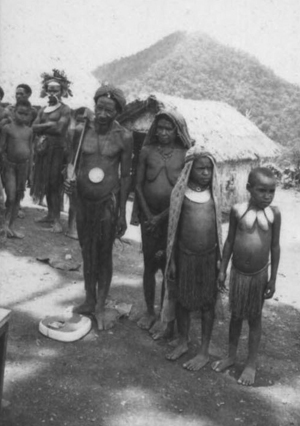
160-16: Tultul Banka and his family. 160-18: Aikapo’s father, mother and sisters.
Bossboy Gul in full bilas stands in the background.
The clip-board holding the list of names was also used to help match the top of people’s heads
to the numbers on the tape measure.
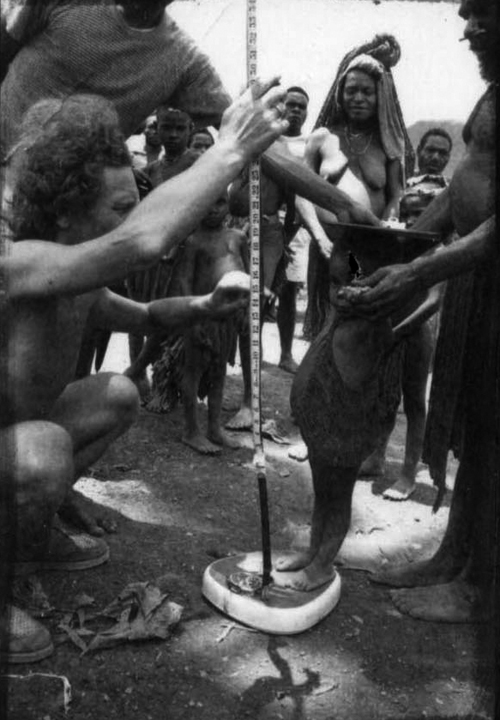
160-21: A tiny child with a large bilum
over its shoulder is held gently on the scale by its father.
| The first of the Fungai clan families to be measured was Bossboy Gul’s. He was highly bilased and stood with his arms crossed firmly on his chest. He was even wearing an angane shell around his neck. |
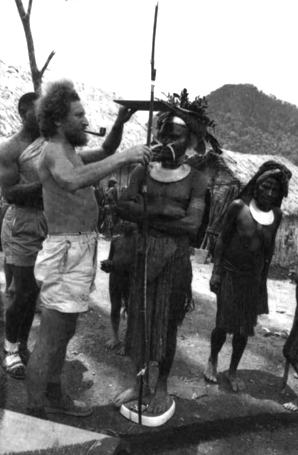
160-23: Marek measures Bosboi Gul, as his wife, Ke, looks on.
| Allison: “I remember that there was a definite problem in figuring out where the “top” of the men’s heads were since they wore so much decoration.” |
| Luluai Pfun and his immediate family were next. His older brother, Awar waited patiently in line. Though he was a very influential person among the Maring themselves, he was never one for show and had never been acknowleged by the Australian Administrtion. Even upon this occasion he only wore a few dried branches of leaves sticking into his belt and, instead of feathers, had affixed a piece of paper to his mamb kun. |
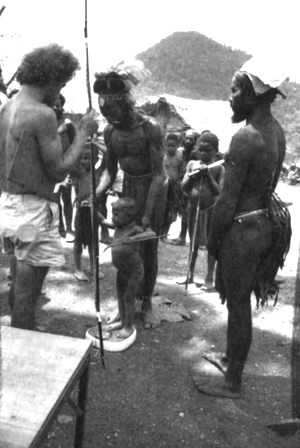
160-29* Pfun steadies Arum on the scale, gently holding her two arms.
| Allison: “Over the course of the preceding months, the little Fungai children had gotten used to our presence in Gunts and Tenegump. A few weeks prior to the weighing and measuring in Tababe, however, a health team giving whooping cough shots had passed by the area. Fearing they were to be given more shots, the little children were scared of us all over again in this official context.” |
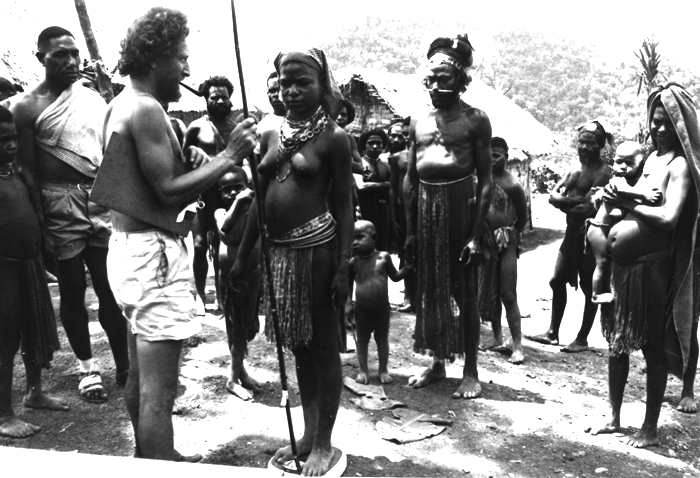
160-33: Pint’ steps on the scale to be weighed and measured. Her father, Pfun, and her little sister; Arum, behind her;
on the right her mother, Komba, holding her little brother, Mbuk.
| Allison: “Not only was this an occasion to get a visual sense of the individual families, but even more it was a moment when the transitional position of the luluais and tultuls could be seen. Dressed in formal finery, and helping direct the positioning of each family, they were, at one and the same time, acting as leaders within their own egalitarian society and as subjects of a colonial administration. The transition was doubly complex since the colonial administration was, itself, in the midst of the process leading to independence. All the people at this gathering would, only 12 years later, become citizens of an independent Papua New Guinea.” |
|
Completed in August, 2011 from details in Chapter 82 of the Yellow Book.
|
Copyright © 1999-2011 Allison Jablonko. All Rights Reserved.


